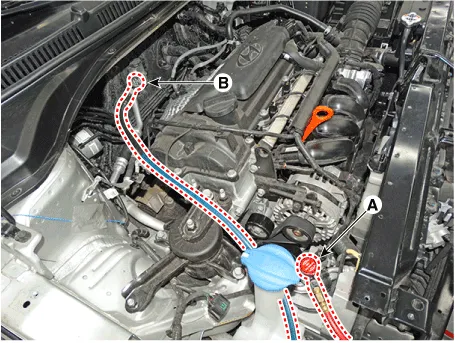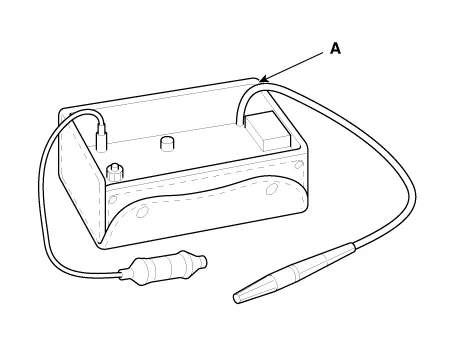Hyundai Accent: Air Conditioning System / Repair procedures
• Do not mix R-1234yf in the vehicle with other refrigerant, such as R-134a and etc.
• Use only service equipment that is U.L-listed and is certified to meet the requirements of SAE standards to recover and recycle R-1234yf from the air conditioning system. Do not use service equipment for the other refrigerant, such as R-134a and etc.
• Verify what refrigerant is in the system if there is concern that the system has been tampered with in any way and check the type and quantity of refrigerant that shall be in the A/C system and potential issues arising from accidental or intentional mixing of refrigerants.
• Using an SAE certified refrigerant identification device is recommended to prevent improper recovery and the resulting further spread of contaminated refrigerant, which could potentially damage other A/C systems and service equipment. Contaminated refrigerant (blend of more than one refrigerant or non-system refrigerant) in recovery / recycling equipment could lead to the potential contamination of more refrigerant.
• Certain types of electronic leak detection devices (heated diode or corona discharge) as well as motors, switches, and controls on recovery and recycling machines, could generate sparks that could serve as ignition sources in the presence of refrigerants classified as flammable (A2 or A3) by ASHRAE standard 34 2006.
• It is possible that the mixing of refrigerants in a A/C system can result in higher-than-expected system pressures, system and component damage, diagnostic errors and/or other potential hazards to people and environment.
• In case other refrigerant is mixed, recover the contaminated refrigerant in the A/C system and dispose it in accordance with all applicable national, regional or local regulations. Clean inside the A/C system using the specialized detergent and recharge new refrigerant.

• Air conditioning refrigerant or lubricant vapor can irritate your eyes, nose, or throat.
• Be careful when connecting service equipment.
• Do not breathe refrigerant or vapor.
If accidental system discharge occurs, ventilate work area before resume of service.Additional health and safety information may be obtained from the refrigerant and lubricant manufacturers.1.Connect an R-1234yf refrigerantRecovery / Recycling / Charging System to the high-pressure service port (B) and the low-pressure service port (A) as shown, following the equipment manufacturer's instructions.

2.Measure the amount of refrigerant oil removed from the A/C system after the recovery process is completed. Be sure to install the same amount of new refrigerant oil back into the A/C system before charging.

• Air conditioning refrigerant or lubricant vapor can irritate your eyes, nose, or throat.
• Be careful when connecting service equipment.
• Do not breathe refrigerant or vapor.
If accidental system discharge occurs, ventilate work area before resume of service.Additional health and safety information may be obtained from the refrigerant and lubricant manufacturers.1.When an A/C System has been opened to the atmosphere, such as during installation or repair, it must be evacuated using an R-1234yf refrigerant Recovery / Recycling / Charging System. (If the system has been open for several days, the receiver / dryer should be replaced, and the system should be evacuated for several hours.)
2.Connect an R-1234yf refrigerantRecovery / Recycling / Charging System to the high-pressure service port and the low-pressure service port as shown, following the equipment manufacturer's instructions.
3.If the low-pressure does not reach more than 87.7 kPa (658 mmHg, 25.9 in.Hg) in 5 minutes, there is probably a leak in the system. Partially charge the system, and check for leaks (see "Refrigerant Leak Test").
4.Remove the low pressure valve from the low-pressure service port.

• Air conditioning refrigerant or lubricant vapor can irritate your eyes, nose, or throat.
• Be careful when connecting service equipment.
• Do not breathe refrigerant or vapor.
If accidental system discharge occurs, ventilate work area before resume of service.Additional health and safety information may be obtained from the refrigerant and lubricant manufacturers.1.Connect an R-1234yf refrigerantRecovery / Recycling / Charging System to the high-pressure service port as shown, following the equipment manufacturer's instructions.
2.Add the same amount of new refrigerant oil to system that was removed during recovery. Use only specified refrigerant oil. Charge the system with 480 ± 25 g (16.9 ± 0.88 oz.) of R-1234yf refrigerant. Do not overcharge the system the compressor will be damaged.

• In order to use the leak detector properly, read the manual supplied by the manufacturer.

• Use only leak detection devices certified to SAE standards for use with R-1234yf. Certain leak detection devices (heated diode or corona discharge) could serve as ignition sources in the presence of hydrocarbons or other flammable refrigerants.
If a gas leak is detected, proceed as follows :1.Check the torque on the connection fittings and, if too loose, tighten to the proper torque. Check for gas leakage with a leak detector (A).
2.If leakage continues even after the fitting has been tightened, discharge the refrigerant from the system, disconnect the fittings, and check their seating faces for damage. Always replace, even if the damage is slight.
3.Check the compressor oil and add oil if required.
4.Charge the system and recheck for gas leaks. If no leaks are found, evacuate and charge the system again.

Other information:
Hyundai Accent (HC) (2017 - 2022) Service Manual: Alternator
- Specification ItemSpecification Rated voltage13.5V, 130A Speed in use 1,000 - 18,000 rpm Voltage regulatorIC Regulator built-in type Regulator Setting VoltageExternal mode 10.6 - 16 ± 0.3V Internal mode14.5 ± 0.3V Temperature GradientExternal mode0 ± 2 mV / °C Internal mode-3.5 ± 2 mV / °C - Description The Alternator has eight built-in diodes, each rectifying AC current to DC current.Hyundai Accent (HC) (2017 - 2022) Service Manual: Integrated Thermal Management Module (ITM)
- Components [Intelligent Variable Transmission (IVT) System] 1. Integrated thermal management module (ITM)2 . Integrated thermal management module (ITM) O-ring3. Heater pipe B4. Heater water hose5. Heater pipe A6 . Heater pipe A gasket7 . Water inlet fitting8 . Water inlet fitting gasket [Manual Transaxle System] 1. Integrated thermal management module (ITM)2 .


